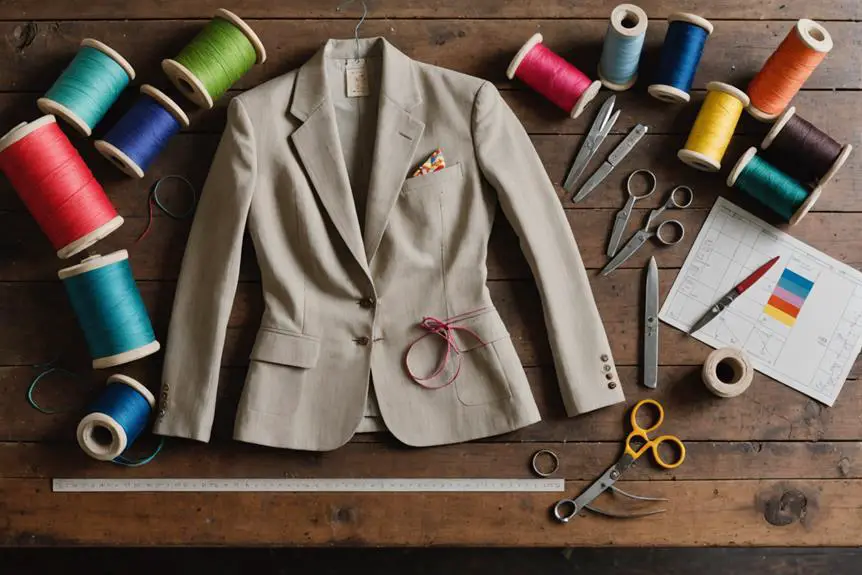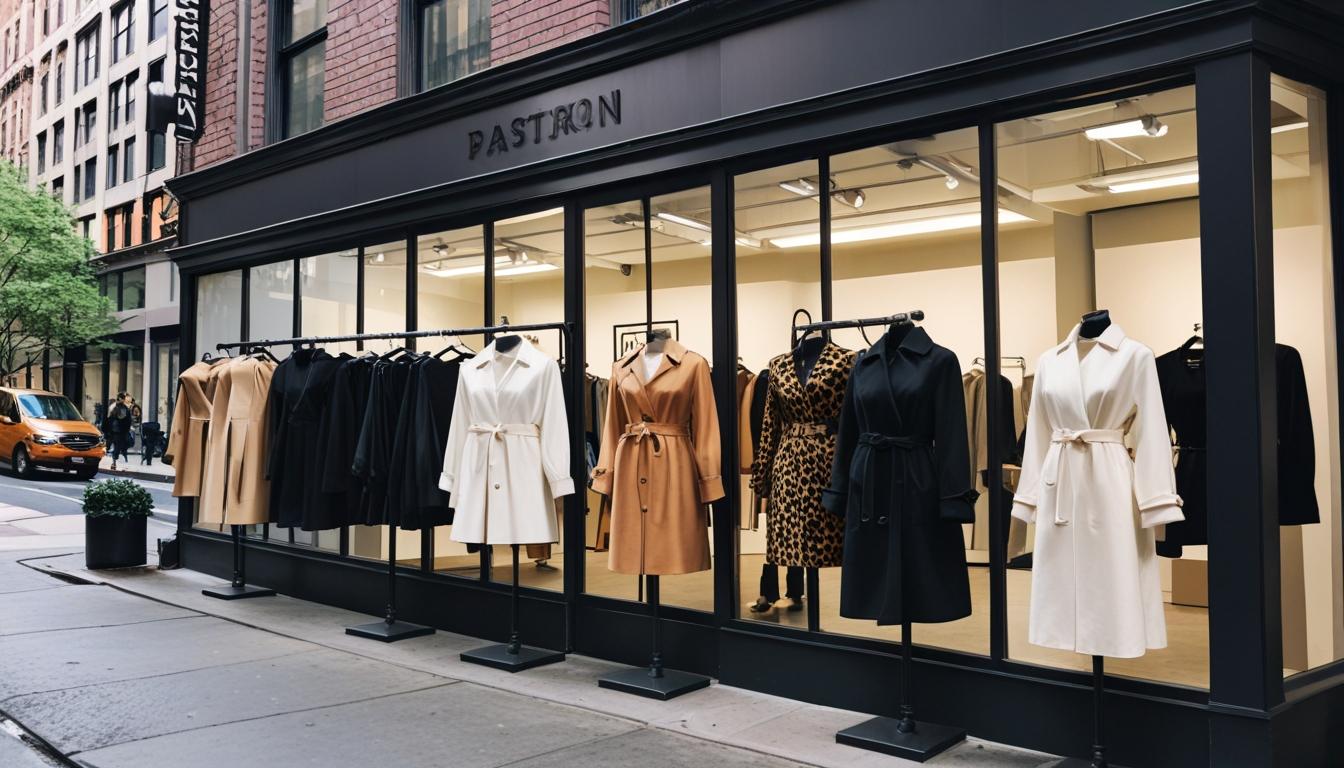A well-fitted blazer can elevate your appearance, while an ill-fitting one can undermine your confidence. You might think tailoring is an overwhelming task, but with the right approach, it's quite manageable. Start by evaluating your blazer for those areas that need attention, guaranteeing you have the right tools at hand. Once you've marked your alterations, you'll discover the satisfaction that comes with transforming a simple garment into something exceptional. So, which steps should you take first to guarantee a perfect fit?
Preparing the Garment
When you start tailoring a blazer, it's essential to assess the garment closely to identify any areas needing alteration, like the side seams, sleeves, or collar. You want your blazer to fit just right, so take your time with this step. First things first, you might need to remove any decorative elements or linings that could get in the way. You don't want anything obstructing your path to those seams! It's also important to assess the fabric type, as some materials may require different techniques for tailoring assessing jacket fit.
Once you've got a clear view, grab some pins and start securing the blazer's fabric along the seams where you'll make adjustments. It's like holding everything in place while you work your magic! Remember to smooth out the fabric so it lies evenly—no one wants a lumpy blazer.
Now, here comes the fun part: using chalk to mark the intended alteration points on the exterior. Make sure your chalk marks are symmetrical; a balanced finish is key to a sharp look. It might feel a bit like you're drawing on a canvas, but this is your masterpiece!
Don't forget to access the interior of the blazer. You can do this through the bottom hem or lining. This way, you can make those necessary adjustments without risking any damage to the exterior fabric. So, ready to transform that blazer? You've got this! With a little patience and attention to detail, you'll create a tailored piece that looks fantastic and fits you perfectly!
Marking and Measuring
To achieve a perfectly tailored blazer, marking and measuring are essential steps in the process. You'll want to grab some tailor's chalk to accurately mark pin positions on the fabric—trust me, it makes a world of difference! Clear visibility for adjustments is key, so don't rush this part. Familiarizing yourself with basic how to tailor clothing techniques can also enhance your confidence during this process.
Start by measuring how much you want to shorten the sleeve. A good rule of thumb is to do this in half-inch increments. It keeps everything balanced, and nobody wants a lopsided blazer, right? Also, take a moment to identify vital reference points like armholes and vents. These spots will guide your seam adjustments, ensuring you keep the blazer's structure intact.
Once you've done that, pin the fabric securely along the seam. Begin from the armhole and work your way down to the vent. This prevents any shifting during the sewing process—no one enjoys a surprise wrinkle when you're done!
Before you cut or sew, double-check all your measurements and marks for symmetry. It's like checking your work before turning it in; precision is essential for a well-fitted blazer.
Sewing Techniques
Sewing techniques play an essential role in achieving a tailored blazer that looks professional and fits perfectly. When you're ready to sew your suit jacket, start by carefully aligning the fabric at the seams. Use pins to hold everything in place—trust me, it'll save you from a world of frustration later! Once everything's pinned, grab your tailor's chalk and mark those desired alterations. Make sure your measurements are balanced and symmetrical; you want an even fit, after all! Remember to take into account the fabric's characteristics, especially if it's a knit, as this could influence your approach to sewing tools and techniques for tailoring.
Now, let's get to the fun part—sewing! Use a backstitch to reinforce your seams, especially at significant points like the armholes and vents. This keeps your blazer from falling apart when you're looking sharp at that fancy event. Remember to pay attention to the side of the seam, as it's important for the overall look.
After you've sewn everything together, take a moment to trim any excess thread. It's all about those little details! Check for puckering or wrinkles—nobody wants a lumpy blazer. You want that polished, professional look, right?
Pressing and Finishing
Pressing and finishing are essential steps in achieving a polished look for your tailored blazer. It's not just about sewing; it's about making your hard work shine! Start by grabbing an arm board. It's your best friend for accessing those tricky spots while pressing. Remember to direct the seam allowance towards the back of the blazer. This little trick helps keep everything neat and tidy. Regular fitting assessments, like ensuring your blazer's shoulders align properly, will also contribute to the overall appearance (fit assessment and importance).
Now, let's talk steam. Incorporating steam while pressing isn't just for show—it's a game-changer! It sets new seams in place, helping you eliminate wrinkles and giving the fabric that polished, professional appearance. While you're at it, don't forget to carefully merge any extra fabric into the vent. This keeps your blazer looking sharp without compromising its shape or length.
A wooden pressing tool, known as a clapper, can be your secret weapon. Use it to achieve a crisp finish on your seams and vents. It absorbs excess moisture and heat, giving your blazer that "wow" factor. But hey, keep an eye out for any wrinkles or puckering during the pressing process. They can sneak up on you and ruin your hard work, so stay vigilant!
Quality Control and Adjustments
Quality control is essential after you've finished sewing your blazer. You want it to look sharp and polished, right? Start by inspecting your garment for any wrinkles, puckering, or uneven seams. These little details can make a big difference in how it looks overall. Next, try on the blazer. Pay close attention to how it fits at the shoulders, chest, and waist. If something feels off, don't hesitate to make those necessary adjustments.
Now, let's talk pressing. Grab your steam iron and give those seams a good press. This helps set the new shape—just be sure to maintain that original crease in the vent. Nobody wants a floppy blazer! If your alterations changed the proportions, check the placement of buttons and pockets. They need to look balanced and functional.
For that professional touch, use waxed thread when hand-sewing the lining. This keeps your stitches invisible on the exterior fabric, which is key for enhancing the overall quality. Who doesn't love a well-finished piece?
Frequently Asked Questions
Is It Easy to Tailor a Blazer?
Tailoring a blazer isn't always easy; it depends on the adjustments you need. Simple techniques can improve blazer fit, but complex alterations require expertise. Assess your needs and choose a skilled tailor for best results.
Is It Possible to Resize a Blazer?
You might think resizing a blazer is impossible, but it's quite doable! With proper measurements, you can achieve a better blazer fitting. Just remember, some adjustments require a skilled tailor for best results.
Can a Readymade Blazer Be Altered?
Yes, you can alter a readymade blazer to improve its fit. Using various alteration techniques, you'll enhance comfort and appearance by adjusting the shoulders, waist, and sleeves to better suit your body shape.
How Much Does It Cost to Adjust a Blazer?
When it comes to blazer adjustments, you're looking at tailoring costs that typically range from $20 to $150. It's wise to get a quote first, so you won't be caught off guard.




